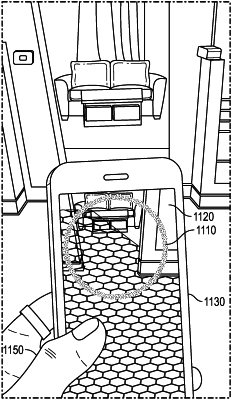| CPC G06F 3/04815 (2013.01) [G06T 19/006 (2013.01); H04W 12/065 (2021.01); H04W 4/029 (2018.02)] | 26 Claims |

|
1. An augmented reality system for enabling enhanced functionality in an environment, the system comprising:
a personal mobile computing device that stores authentication information, the personal mobile computing device including a device memory that stores device computer instructions and a device processor that when executing the device computer instructions causes the personal mobile computing device to:
display a multi-dimensional fabric user interface in an augmented reality virtual environment that represents a first actual physical location to the user of the personal mobile computing device based on valid authentication of the personal mobile computing device; and
receive input from the user; and
the remote server includes a server memory that stores server computer instructions and a server processor that when executing the server computer instructions causes the remote server to:
manipulate the multi-dimensional fabric user interface to the user based on received input from the user via the associated personal mobile computing device;
enable the user to create a portal in the virtual representation of the first actual physical location that facilitates travel to a virtual representation of a second actual physical location in the multi-dimensional fabric user interface, the portal having a first location side and a second location side that each enable travel to their other location side, wherein the remote server enables the user to anchor the first location side of the portal to a specific location within the multi-dimensional fabric, and wherein the remote server enables the user to anchor the second location side of the portal to another specific location within the multi-dimensional fabric;
enable the user to enter the first location side of the portal and travel to the virtual representation of the second actual physical location in the multi-dimensional fabric user interface from the virtual representation of the first actual physical location in the multi-dimensional fabric user interface; and
while in the multi-dimensional fabric user interface that virtually represents the second actual physical location, enable the user to interact with virtual objects in the virtual representation of the second actual physical location and other users at the virtual representation of the second actual physical location to execute one or more of the following actions: upload data, download data, post data, and live stream data.
|